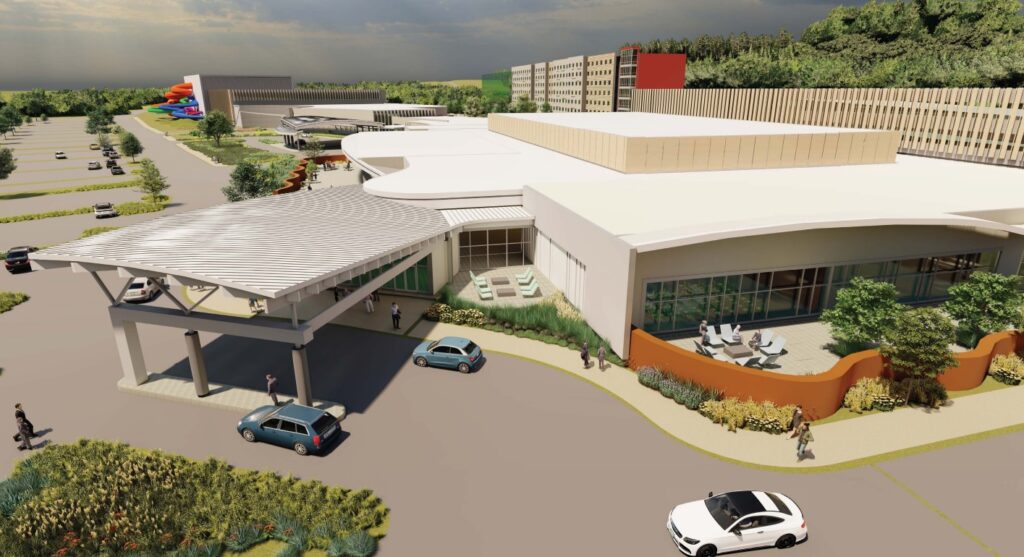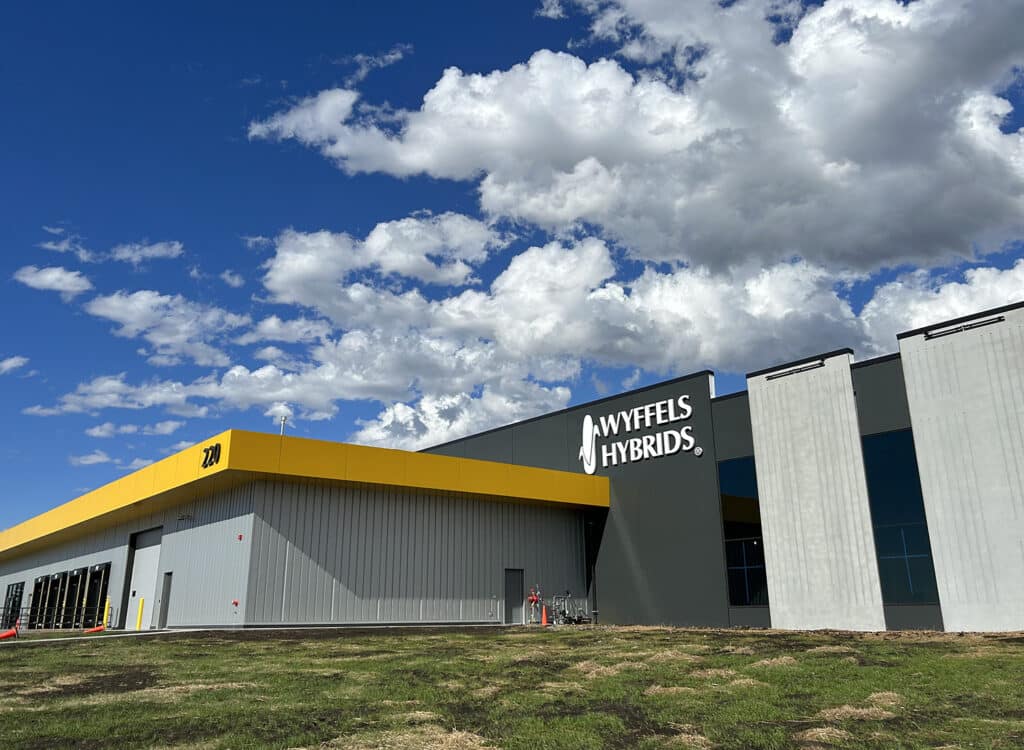Construction of new federal courthouse slowed by pandemic
Project now expected to be completed by mid-2023

KATHY A. BOLTEN Aug 30, 2022 | 7:54 pm
7 min read time
1,717 wordsBusiness Record Insider, Real Estate and Development
In late August 2019, federal and local dignitaries gathered at a site overlooking the Des Moines River for a groundbreaking ceremony for a new federal courthouse.
Several noted that by late 2022, federal judicial employees in the U.S. District Court for the Southern District of Iowa would be working out of a newly constructed, spacious and secure courthouse.
The pandemic and the havoc it wreaked on the supply chain have slowed the project, which now is expected to be completed by mid-2023.
Roofing materials were among the products difficult to procure, said Brad Thomason, senior project executive of construction for Ryan Cos. US Inc. and the project’s construction manager. The materials for the roof were ordered in July 2021. It took until January to get all of the materials, he said.
“It’s a glued-down roof system,” he said. “We got everything we needed in the winter, when it’s cold and windy. So, we couldn’t do anything. Then it rains. … Once we had everything, the weather got in the way.”
It has taken longer than usual to obtain other materials as well, including an overhead door that was ordered nearly 50 weeks ago, Thomason said. “Fortunately, it’s a long project so if you get ahead of it, it’s not a big deal.”
The U.S. General Services Administration announced in July 2017 that it had selected a 2-acre parcel on the west bank of the Des Moines River between Grand and Locust avenues as the site for the new federal courthouse. The site originally was home to the Des Moines Coliseum and later the Riverfront YMCA.
Congress authorized $140.6 million for the project, which includes purchase of the site, design, construction and other related expenses.
Currently, the U.S. District Court for the Southern District of Iowa occupies two buildings east of the Des Moines River: the current federal courthouse at 123 E. Walnut St. that was built in 1929, and an annex at 110 E. Court Ave. The federal government leases space in the annex, which is privately owned.
The new courthouse has numerous features not included in the Southern District’s current facilities, Chief District Judge Stephanie Rose said.
“It’s going to have a covered entry and foyer so the public and jurors won’t have to wait outside in the elements; they’ll be inside while they are going through security,” she said.
An education center, with views of the Des Moines River, will be located on the first floor. Jurors and others will have access to educational material and items of interest to the Southern District of Iowa, Rose said. Also on the first floor will be a jury assembly room that will double as an event room.
“When jurors aren’t there, we will be able to use that room for large gatherings … events where it will be nice to have some space to get together,” Rose said. “Now we occasionally will convert a courtroom [to be used for large gatherings] but that presents some of its own challenges because a lot of features in the courtroom can’t be moved.”
The new courthouse will also have state-of-the-art technology and security provisions, Rose said. It has been difficult to update technology and security measures in the existing courthouse because of its age, she said. The structure was built 93 years ago.
“The challenges to providing security to judges and courtrooms is really something that we have to take seriously moving into the future,” Rose said. “We have to do what they call ‘courthouse hardening,’ meaning our courthouses have to be secure from the outside against … breaches of any kind and our judges have to be secure within their courtrooms to do the jobs that they do without facing threats to their physical safety.”
The new courthouse will include 13 judges’ chambers and nine courtrooms with enough space for family members, victims, the public and others to watch proceedings. The existing courthouse has five courtrooms; the bankruptcy courtroom is located in the annex.
While having a courtroom for each judge will be convenient, it also will present challenges, Rose said. “We can’t have all nine courtrooms going simultaneously because we don’t have enough marshals to handle it and we don’t want lawyers to get double booked.”
Court administrators are working on developing a system in which to schedule hearings so that there is a mix of civil and criminal proceedings occurring and not all criminal hearings, Rose said.
The new courthouse will also provide offices and workspace for U.S. Probation and Pretrial Services, the U.S. Marshals Service, federal public defenders and U.S. attorneys, a law library, and a judicial education center.
Underground parking will be provided for the judges, who will enter the building through a secure access.
When visitors to the courthouse enter the east side of the building, they’ll see a large Great Seal of the United States etched in frosted glass. The seal will also be at the top of the building’s west-facing side.
The foyer behind the security guard station will be surrounded with columns that stretch from the ground floor to the third. The columns will be covered with stone. Written on the stone will be texts from myriad historical legal documents, Thomason said. “You’ll be able to read them from the different floors.”
Also on the first floor will be a ceremonial courtroom where naturalization ceremonies and other special events will occur.
Dozens of trees will be planted on berms that will surround the building, Thomason said.
“It’s going to make it very difficult for a car to drive from the curb into the building,” he said.
By the numbers
The federal courthouse under construction at 101 Locust St. includes:
14,350 cubic yards of concrete, enough to make a 15-foot-thick block of concrete the size of a football field.
2.4 million pounds of reinforcing steel, the same number of pounds as five Statue of Liberties.
215+ miles of electrical wire, enough to stretch between Des Moines and Kansas City, Mo.
What will happen to existing federal courthouse?
Three nonprofit or public entities have submitted proposals for public uses for the existing historic federal courthouse at 123 E. Walnut St. in Des Moines, a spokesperson for the U.S. General Services Administration said.
The identities of the entities will remain secret until reviews of the proposals are completed, Charlie Cook, GSA spokesperson, wrote in an email. Cook cited an exemption under the Freedom of Information Act that allows the information to remain confidential.
The courthouse, constructed between 1927 and 1929, is considered excess federal property and is currently in the process of being disposed of by the U.S. General Services Administration, which manages all of the federal government’s properties.
In the past 10 years, the GSA has disposed of 13 courthouse properties, according to Cook. Currently, three other U.S. courthouse properties are in the disposal process, he wrote.
One of the first steps in disposing of the property is screening proposals for other public use or homeless needs.
According to a GSA document, public uses can include community centers, schools and colleges, emergency management facilities and others. In addition, homeless assistance groups, state and local governments, eligible nonprofit organizations, and other community-based institutions can submit proposals for public uses of the federal property.
It will take up to 150 days for the proposals to be reviewed and for decisions to be made on whether any of the three proposals are “eligible to repurpose the property for public use,” Cook wrote. Officials from the U.S. Department of Health and Human Services will make that determination, he wrote.
A spokesperson for the city of Des Moines, which has facilities near the federal courthouse, has said the city is not interested in the property. Polk County officials have also said they are not interested in the property.
If none of the three entities that submitted proposals is allowed to acquire the building, it will be sold during an online auction.
At least one local developer is interested in acquiring the property, possibly converting it into housing.
Developer Jake Christensen said if the property is sold at auction, he would likely submit a bid.
“The general makeup of the building makes it a little bit difficult for a lot of uses,” Christensen said. “To me, the logical uses are higher-end apartments or condos and then maybe a boutique hotel.”
The five-level courthouse is on the National Register of Historic Places.
The courthouse is one of seven monumental public buildings constructed along the Des Moines River in the first half of the 1990s, according to the GSA’s website. In 1988, the riverfront area, including the courthouse, was designated the Civic Center Historic District and listed in the National Register of Historic Places.
Erin Olson-Douglas, Des Moines’ development services director, said she’s hopeful that whoever acquires the federal property redevelops it in a way that activates the riverfront. The courthouse property, originally developed in the late 1920s, is one block east of the Des Moines River.
“It’s a spot where you could have a cool hotel, you could do housing, you could do office space,” Olson-Douglas said. “I think something with activity would be welcome there.”
Preserving the historical significance of the building is also important, she said.
The first ruling involving the landmark Tinker v. Des Moines Independent School District occurred in a courtroom of the federal courthouse. (The school district banned students from wearing black armbands to protest the Vietnam War. Some students who defied the ban were suspended from school, prompting their parents to file a lawsuit against the district.)
A judge for the U.S. District Court for the Southern District of Iowa ruled in favor of the school district, saying that wearing the armbands could disrupt learning. The ruling was appealed, ultimately ending up before the U.S. Supreme Court, which in 1969 ruled in favor of the students.
“Recognizing that that history is an important piece for both our community as well as the broader impact the decision has had across the country,” Olson-Douglas said, “finding a way to have public accessibility [to the courtroom] is important.”
The courtrooms in the building likely will have to be preserved, Christensen said. “Maybe they can be used as community rooms or some other type of public space or use. It will be a challenge.”








